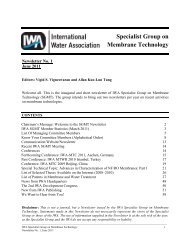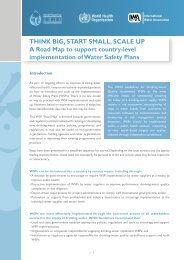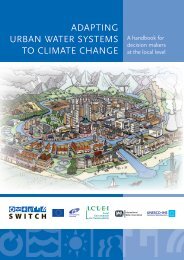Sanitation 21 planning framework - IWA
Sanitation 21 planning framework - IWA
Sanitation 21 planning framework - IWA
- No tags were found...
Create successful ePaper yourself
Turn your PDF publications into a flip-book with our unique Google optimized e-Paper software.
<strong>Sanitation</strong> <strong>21</strong>who have an interest in promoting or hinderingprogress on sanitation and what are their capacitiesin terms of mandate, staff power and skills andcrucially funds.3.5 The Context ChecklistBased on our interpretation of the order ofimportance of interests, external factors andcapacity considerations we have developed thefollowing generic checklist (Table 3). Table 3can be used as a starting point for assessingthe context within which sanitation systems areoperating. Clearly the details of the analysis willvary between different towns and cities. Thebroad outline however holds good for a widerange of cases and is worth examining in detail.A range of tools are available for assessing thedrivers/objectives in detail at each level. These aresummarised in Annexe 2.PART TWO:Technical Options3.6 The components of the systemIn systems-terms sanitation consists of somecombination of:• A toilet• Collection mechanism• Transportation mechanism• Treatment process• Disposal/ re-use mechanism/ process.Engineers or technicians generally considerthemselves familiar with the full range of technicaloptions for each of these components. However, inmany cases, they exhibit biases which may excludesome options from consideration altogether. Toillustrate, a list of technologies taken from a recentpublication on ‘Smart <strong>Sanitation</strong> Solutions’ isshown in the first column of Table 4. Alternative Smart <strong>Sanitation</strong> Smart <strong>Sanitation</strong> Solutions - Examplesof innovative, low-cost technologies for toilets, collection,transportation, treatment and use of sanitation products (2006)NetherlandsWater Partnership, WASTE, PRACTICA, IRC and SIMAVI. Thispublication as its title suggests is an excellent introduction andpractical guide for use of more innovative and less ‘conventional’technologies which can have many advantages in the rightcircumstances. The authors are clearly aware of a much widerrange of options but have chosen to focus attention on nonnetworkedsolutions because of the relative lack of attention theyusually attract.options, taken from a more ‘conventional’ sourcewith a focus on networked sanitation are includedin the second column of the table. Both lists havemerit in their own right – for the situations forwhich they were developed. But it only when theyare taken together that the two columns begin toshow a more comprehensive listing of technicaloptions; and even then the list is probably notcomplete. Taken alone neither column presents thefull picture.This table also illustrates an interesting effectof making the fundamental assumption thatnetworked conventional sanitation is to be used;options for wastewater treatment proliferate,but options further upstream are extremelyconstrained. For example water borne seweragerequires water flushed toilets and its useprecludes most other toilet options. By contrastnon-networked and dry systems present morechoices and options at the toilet/ collection endof the system while also offering some additionaltreatment/disposal/ re-use options.3.7 The system as a wholeOf course, technical choices made for eachcomponent of a system are highly interdependent(no engineer would suggest the need for a cartageapproach if water closets are in use). But iftechnical assumptions are fixed and not challengedsome of the objectives of the sanitation systemwe discussed earlier may not be achievable. Toexpand on the example given above, if only waterflushed toilets can be used because networkedsewerage has already been selected, then onlypeople with house connections to the water systemare likely to be connected to sanitation. If theutility only serves 40% of the population, thenthe remaining 60% are by definition not goingto benefit from investments made in sanitation.Similarly, if water flushed toilets are the norm anda networked sewerage system exists, but there isneither land nor operating budget available to runa wastewater treatment plant, then downstreamwaterbodies are going to receive large volumes ofuntreated effluent and environmental objectivesmay not be achievable.The challenge for the planners, designers andmanagers of the system is, while understanding allthe drivers and options, to balance the objectives– 19 –
















